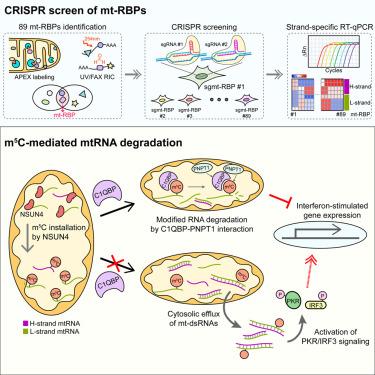Our official English website, www.x-mol.net, welcomes your
feedback! (Note: you will need to create a separate account there.)
RNA 5-methylcytosine marks mitochondrial double-stranded RNAs for degradation and cytosolic release
Molecular Cell ( IF 14.5 ) Pub Date : 2024-07-16 , DOI: 10.1016/j.molcel.2024.06.023 Sujin Kim 1 , Stephanie Tan 1 , Jayoung Ku 1 , Tria Asri Widowati 1 , Doyeong Ku 1 , Keonyong Lee 1 , Kwontae You 2 , Yoosik Kim 3
Molecular Cell ( IF 14.5 ) Pub Date : 2024-07-16 , DOI: 10.1016/j.molcel.2024.06.023 Sujin Kim 1 , Stephanie Tan 1 , Jayoung Ku 1 , Tria Asri Widowati 1 , Doyeong Ku 1 , Keonyong Lee 1 , Kwontae You 2 , Yoosik Kim 3
Affiliation

|
Mitochondria are essential regulators of innate immunity. They generate long mitochondrial double-stranded RNAs (mt-dsRNAs) and release them into the cytosol to trigger an immune response under pathological stress conditions. Yet the regulation of these self-immunogenic RNAs remains largely unknown. Here, we employ CRISPR screening on mitochondrial RNA (mtRNA)-binding proteins and identify NOP2/Sun RNA methyltransferase 4 (NSUN4) as a key regulator of mt-dsRNA expression in human cells. We find that NSUN4 induces 5-methylcytosine (mC) modification on mtRNAs, especially on the termini of light-strand long noncoding RNAs. These mC-modified RNAs are recognized by complement C1q-binding protein (C1QBP), which recruits polyribonucleotide nucleotidyltransferase to facilitate RNA turnover. Suppression of NSUN4 or C1QBP results in increased mt-dsRNA expression, while C1QBP deficiency also leads to increased cytosolic mt-dsRNAs and subsequent immune activation. Collectively, our study unveils the mechanism underlying the selective degradation of light-strand mtRNAs and establishes a molecular mark for mtRNA decay and cytosolic release.
中文翻译:

RNA 5-甲基胞嘧啶标记线粒体双链 RNA 的降解和胞质释放
线粒体是先天免疫的重要调节因子。它们产生长线粒体双链 RNA (mt-dsRNA) 并将其释放到细胞质中,在病理应激条件下触发免疫反应。然而,这些自身免疫原性 RNA 的调控仍然很大程度上未知。在这里,我们对线粒体 RNA (mtRNA) 结合蛋白进行 CRISPR 筛选,并鉴定出 NOP2/Sun RNA 甲基转移酶 4 (NSUN4) 作为人类细胞中 mt-dsRNA 表达的关键调节因子。我们发现 NSUN4 诱导 mtRNA 上的 5-甲基胞嘧啶 (mC) 修饰,尤其是在轻链长非编码 RNA 的末端。这些 mC 修饰的 RNA 被补体 C1q 结合蛋白 (C1QBP) 识别,该蛋白招募多核糖核苷酸核苷酸转移酶以促进 RNA 周转。 NSUN4 或 C1QBP 的抑制会导致 mt-dsRNA 表达增加,而 C1QBP 缺陷也会导致胞质 mt-dsRNA 增加和随后的免疫激活。总的来说,我们的研究揭示了轻链 mtRNA 选择性降解的机制,并建立了 mtRNA 降解和胞质释放的分子标记。
更新日期:2024-07-16
中文翻译:

RNA 5-甲基胞嘧啶标记线粒体双链 RNA 的降解和胞质释放
线粒体是先天免疫的重要调节因子。它们产生长线粒体双链 RNA (mt-dsRNA) 并将其释放到细胞质中,在病理应激条件下触发免疫反应。然而,这些自身免疫原性 RNA 的调控仍然很大程度上未知。在这里,我们对线粒体 RNA (mtRNA) 结合蛋白进行 CRISPR 筛选,并鉴定出 NOP2/Sun RNA 甲基转移酶 4 (NSUN4) 作为人类细胞中 mt-dsRNA 表达的关键调节因子。我们发现 NSUN4 诱导 mtRNA 上的 5-甲基胞嘧啶 (mC) 修饰,尤其是在轻链长非编码 RNA 的末端。这些 mC 修饰的 RNA 被补体 C1q 结合蛋白 (C1QBP) 识别,该蛋白招募多核糖核苷酸核苷酸转移酶以促进 RNA 周转。 NSUN4 或 C1QBP 的抑制会导致 mt-dsRNA 表达增加,而 C1QBP 缺陷也会导致胞质 mt-dsRNA 增加和随后的免疫激活。总的来说,我们的研究揭示了轻链 mtRNA 选择性降解的机制,并建立了 mtRNA 降解和胞质释放的分子标记。
















































 京公网安备 11010802027423号
京公网安备 11010802027423号